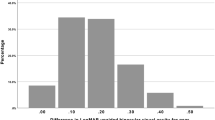Background: After unilateral photorefractive keratectomy (PRK) for myopia correction, relative mydriasis of the treated eye was noticed. The aim of this study was to determine the incidence and possible etiology of this anisocoria.
Patients and methods: In a prospective clinical study we examined eight consecutive patients after PRK of a spherical equivalent of –1.0 to –8.5 D with a 6.5–7.0 mm optical zone (Schwind-Keratom) for up to 10 months. Measurements of the pharmacological uninfluenced pupillary diameter were carried out with a Goldmann perimeter under 31.5 asb and under four different room light and distance conditions. In five patients a hard contact lens of 0 D power was fitted to the treated eye, so that the laser-induced central corneal flattening was compensated for by the sublenticular tear film, and the pupillary diameter was measured again. The influence of pilocarpine 0.1 % eye drops to the pupil was also examined.
Results: Postoperatively, the pupil of the PRK-treated eye measured up to 1.75 mm larger than that of the fellow eye in all patients. The amount of anisocoria showed a small negative correlation with the interval between the PRK procedure and the day of measurement. It did not correlate significantly with the amount of induced refractive change, applied energy, application of pilocarpine 0.1 % eye drops or the contact lens fitting.
Conclusion: After unilateral PRK, anisocoria can regularly be observed. At present its definite pathogenesis is unclear, although certain possible optical and neuronal mechanisms have been excluded. The most probable etiology is a mild lesion of the pupillary sphincter muscle because of its localization in the center of the laser shock wave distribution.
Fragestellung: Nach einseitiger Excimer-photorefraktiver Keratektomie (PRK) zur Myopiekorrektur wurde mehrfach eine relative Pupillenerweiterung des behandelten Auges beobachtet. Ihrer Inzidenz und möglichen Ursachen sollte nachgegangen werden.
Patienten und Methode: Im Rahmen einer prospektiven klinischen Studie wurden acht konsekutive Patienten nach unilateraler Korrektur von –1,0 bis –8,5 dpt mit sphärischer Abtragungszone von 6,5–7,0 mm (Schwind-Keratom) untersucht und bis zu 10 Monaten postoperativ kontrolliert. Dabei wurde der medikamentös unbeeinflußte Pupillendurchmesser in der Goldmann-Perimeter-Kugel bei 31,5 asb und mit einer handelsüblichen Meßscheibe unter 4 verschiedenen Licht- und Entfernungsbedingungen im freien Raum vermessen. Bei 5 Patienten wurde mit Hilfe einer formstabilen Kontaktlinse der Brechkraft 0 dpt auf dem behandelten Auge und der entsprechend resultierenden Tränenlinse die Laserablation der Hornhautoberfläche optisch kompensiert und die Pupillenweite erneut gemessen. Die Wirkung von 0,1 %igen Pilocarpin-Augentropfen auf die Pupillenweite wurde ebenfalls untersucht.
Ergebnisse: Bei allen Patienten ließen sich postoperativ Pupillenseitendifferenzen bis zu 1,75 mm zugunsten des behandelten Auges messen. Das Ausmaß der Anisokorie war geringfügig negativ korreliert mit dem Zeitintervall zwischen der PRK und der Messung. Ansonsten war ihr Ausmaß weder von der erreichten Refraktionsänderung, der applizierten Energie, der Applikation von 0,1 %igen Pilocarpin-Augentropfen noch von der Kontaktlinsenanpassung signifikant abhängig.
Schlußfolgerung: Für diese offenbar regelmäßig auftretende Anisokorie ließen sich optische und neuronale Ursachen ausschließen. Unter Berücksichtigung der Ausbreitungscharakteristik der Laserstoßwellen ist eine muskuläre Läsion des Pupillensphinkters die wahrscheinlichste Ursache.
Similar content being viewed by others
Author information
Authors and Affiliations
Rights and permissions
About this article
Cite this article
Neppert, B., Geerling, G., Wirbelauer, C. et al. Anisocoria after unilateral photorefractive keratectomy – expression of a lesion of the pupillary sphincter muscle?. Ophthalmologe 96, 227–233 (1999). https://doi.org/10.1007/s003470050397
Issue Date:
DOI: https://doi.org/10.1007/s003470050397




